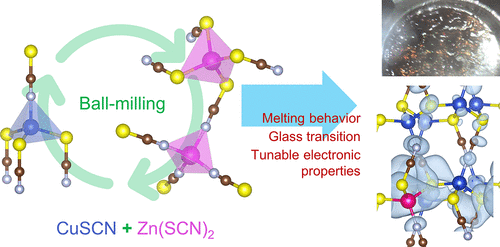当前位置:
X-MOL 学术
›
Inorg. Chem.
›
论文详情
Our official English website, www.x-mol.net, welcomes your feedback! (Note: you will need to create a separate account there.)
Mixed-Metal Cu–Zn Thiocyanate Coordination Polymers with Melting Behavior, Glass Transition, and Tunable Electronic Properties
Inorganic Chemistry ( IF 4.6 ) Pub Date : 2021-10-19 , DOI: 10.1021/acs.inorgchem.1c01813 Chayanit Wechwithayakhlung 1, 2 , Suttipong Wannapaiboon 3 , Sutassana Na-Phattalung 4, 5 , Phisut Narabadeesuphakorn 1 , Similan Tanjindaprateep 1 , Saran Waiprasoet 1 , Thidarat Imyen 2 , Satoshi Horike 1, 2 , Pichaya Pattanasattayavong 1, 6
Inorganic Chemistry ( IF 4.6 ) Pub Date : 2021-10-19 , DOI: 10.1021/acs.inorgchem.1c01813 Chayanit Wechwithayakhlung 1, 2 , Suttipong Wannapaiboon 3 , Sutassana Na-Phattalung 4, 5 , Phisut Narabadeesuphakorn 1 , Similan Tanjindaprateep 1 , Saran Waiprasoet 1 , Thidarat Imyen 2 , Satoshi Horike 1, 2 , Pichaya Pattanasattayavong 1, 6
Affiliation

|
The solid-state mechanochemical reactions under ambient conditions of CuSCN and Zn(SCN)2 resulted in two novel materials: partially Zn-substituted α-CuSCN and a new phase CuxZny(SCN)x+2y. The reactions take place at the labile S-terminal, and both products show melting and glass transition behaviors. The optical band gap and solid-state ionization potential can be adjusted systematically by adjusting the Cu/Zn ratio. Density functional theory calculations also reveal that the Zn-substituted CuSCN structure features a complementary electronic structure of Cu 3d states at the valence band maximum and Zn 4s states at the conduction band minimum. This work shows a new route to develop semiconductors based on coordination polymers, which are becoming technologically relevant for electronic and optoelectronic applications.
中文翻译:

具有熔融行为、玻璃化转变和可调电子特性的混合金属 Cu-Zn 硫氰酸酯配位聚合物
CuSCN 和 Zn(SCN) 2在环境条件下的固态机械化学反应产生了两种新材料:部分 Zn 取代的 α-CuSCN 和新相 Cu x Zn y (SCN) x +2 y. 反应发生在不稳定的 S 端,两种产物都表现出熔融和玻璃化转变行为。可以通过调节 Cu/Zn 比来系统地调节光学带隙和固态电离电位。密度泛函理论计算还表明,Zn 取代的 CuSCN 结构具有价带最大值处的 Cu 3d 态和导带最小值处的 Zn 4s 态的互补电子结构。这项工作展示了开发基于配位聚合物的半导体的新途径,这些聚合物在技术上与电子和光电应用相关。
更新日期:2021-11-01
中文翻译:

具有熔融行为、玻璃化转变和可调电子特性的混合金属 Cu-Zn 硫氰酸酯配位聚合物
CuSCN 和 Zn(SCN) 2在环境条件下的固态机械化学反应产生了两种新材料:部分 Zn 取代的 α-CuSCN 和新相 Cu x Zn y (SCN) x +2 y. 反应发生在不稳定的 S 端,两种产物都表现出熔融和玻璃化转变行为。可以通过调节 Cu/Zn 比来系统地调节光学带隙和固态电离电位。密度泛函理论计算还表明,Zn 取代的 CuSCN 结构具有价带最大值处的 Cu 3d 态和导带最小值处的 Zn 4s 态的互补电子结构。这项工作展示了开发基于配位聚合物的半导体的新途径,这些聚合物在技术上与电子和光电应用相关。



























 京公网安备 11010802027423号
京公网安备 11010802027423号